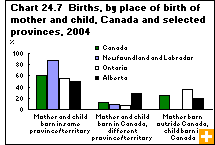Common menu bar links
Migration influencing birth trends
Archived Content
Information identified as archived is provided for reference, research or recordkeeping purposes. It is not subject to the Government of Canada Web Standards and has not been altered or updated since it was archived. Please contact us to request a format other than those available.
Each year, many Canadians pack up and move to a different province or territory. This interprovincial migration is one of the major factors behind the variations in birth rates among the provinces, as is immigration from other countries. These migrants have children in a province or territory other than where they were born, changing Canada’s demographic picture.
Many young people in their child-bearing years leave Newfoundland and Labrador for other provinces and the result is fewer births in that province. In 2004, women living in Newfoundland and Labrador gave birth to 4,598 babies—about half the 8,929 babies born in 1983.
The population of Newfoundland and Labrador has a low population replacement rate. The number of people leaving the province is greater than the number of people settling there. In 2004, Newfoundland and Labrador had the lowest proportion of births to women born outside Canada (less than 1 birth in 100) or born elsewhere in Canada (9 births in 100).
Alberta was the only province with an increase in births for a fourth consecutive year in 2004. Alberta’s baby boom is largely attributable to many young people moving in from other parts of the country. In Alberta, 29 babies out of 100 were born to women from other parts of Canada, and 20 babies out of 100 were born to immigrants.
Ontario has a much higher proportion of babies born to immigrant women. Just 8 of 100 babies were born to women who were born elsewhere in Canada, 56 out of 100 babies in the province were born to women who were born in Ontario, and 36 of 100 babies were born to immigrant women.



